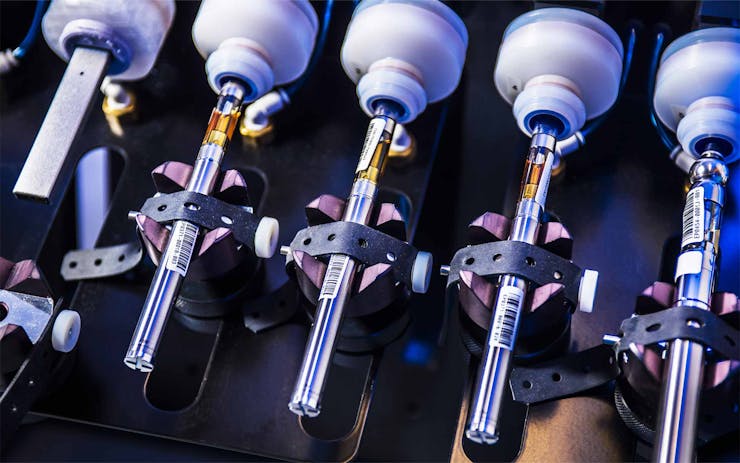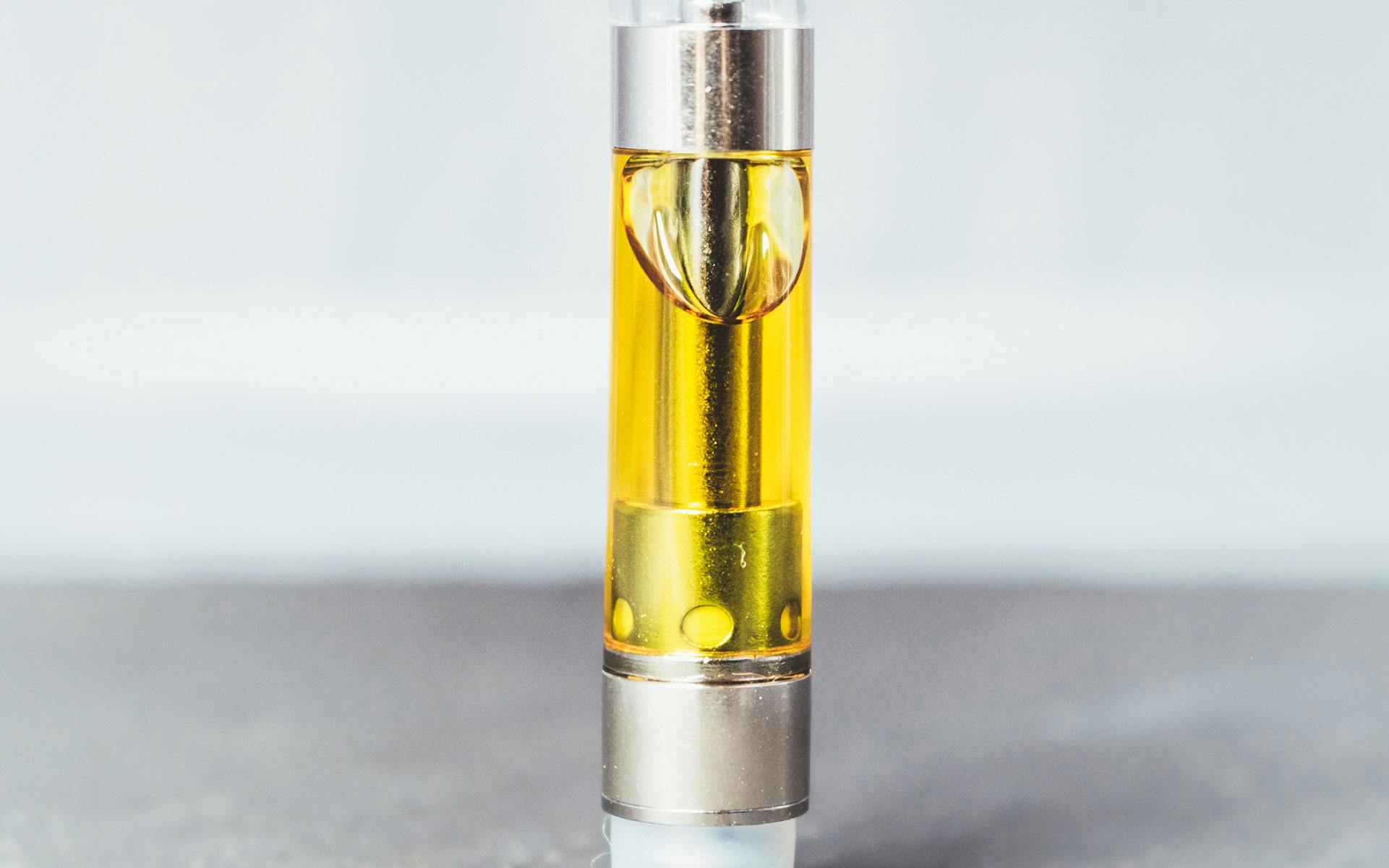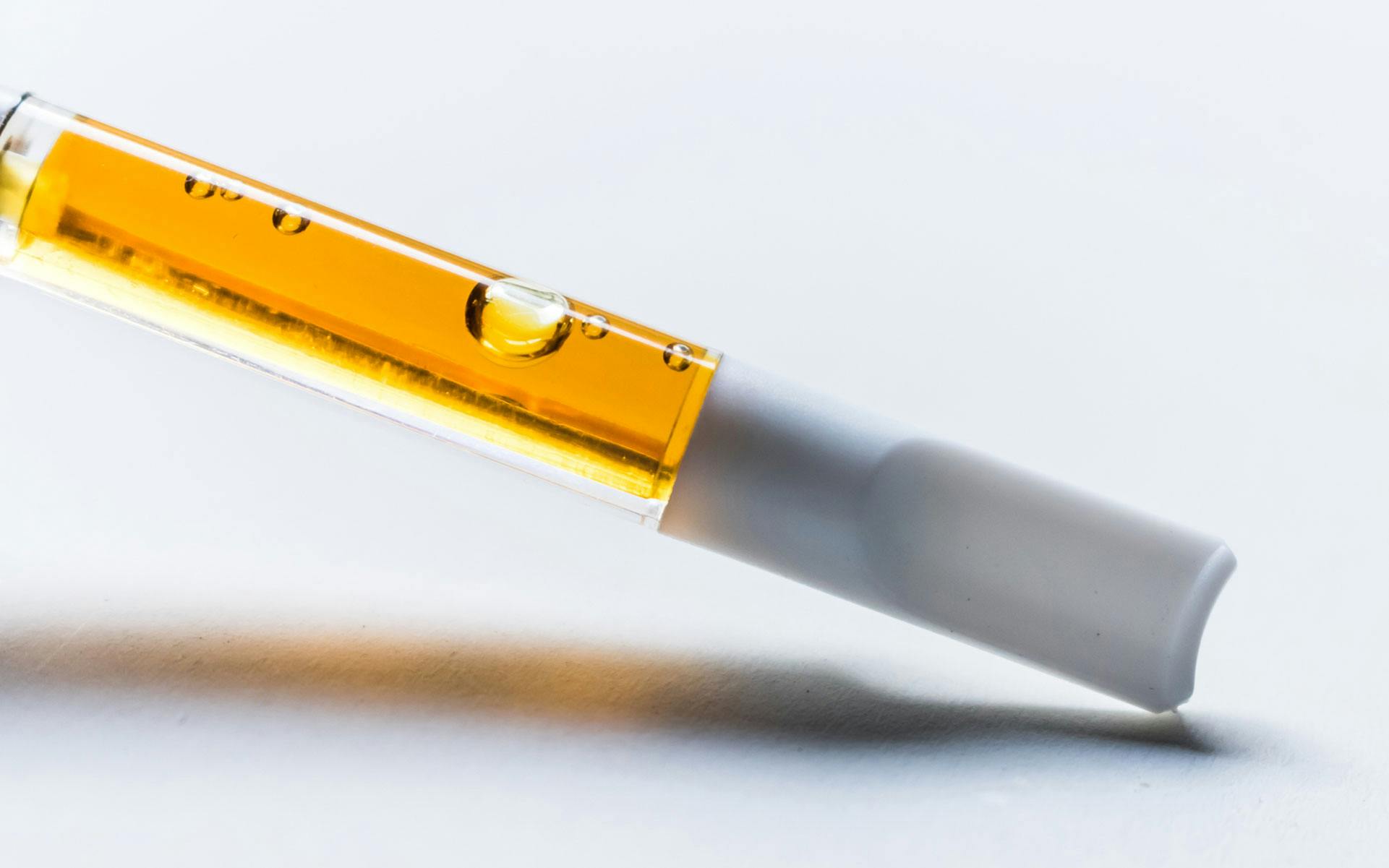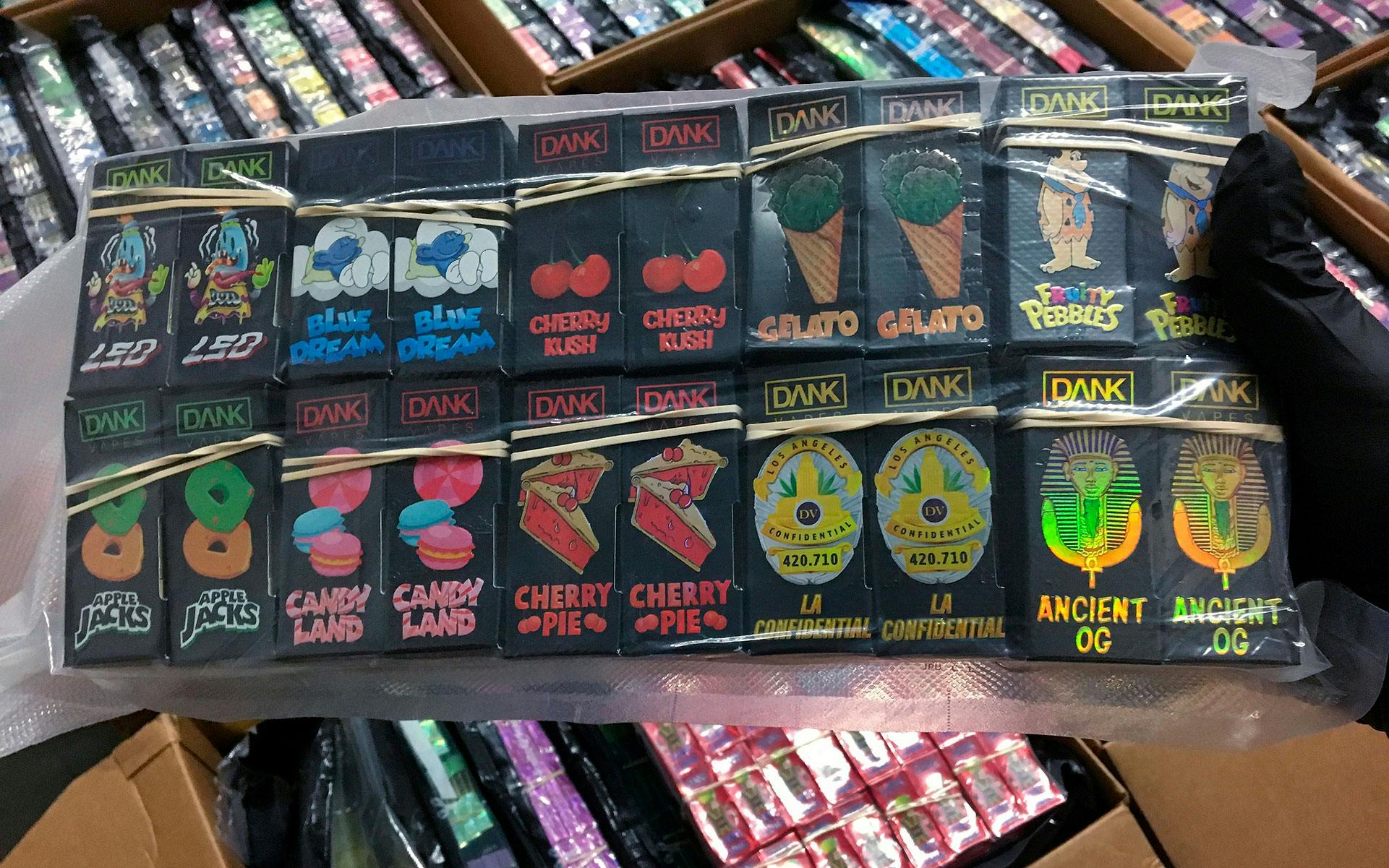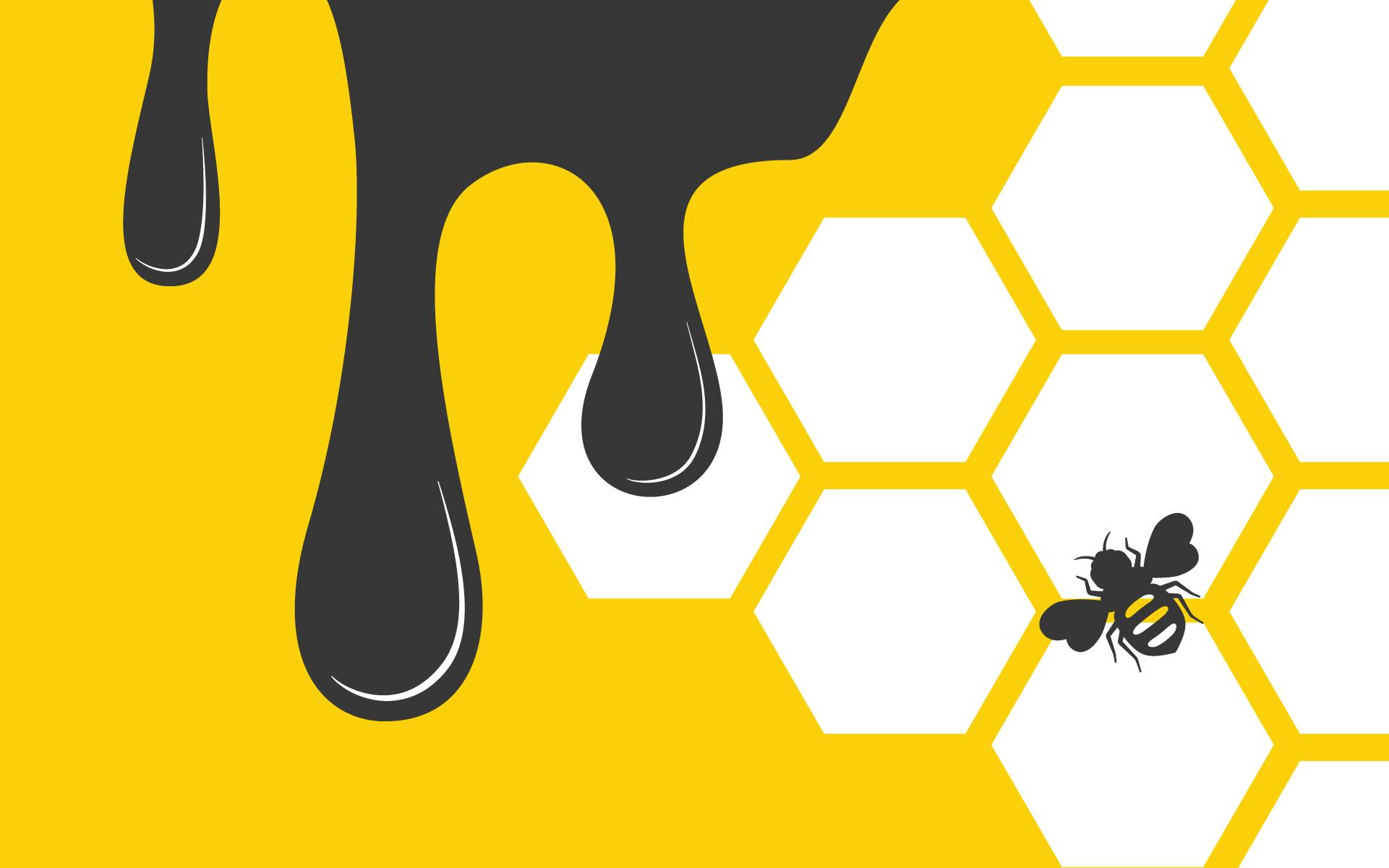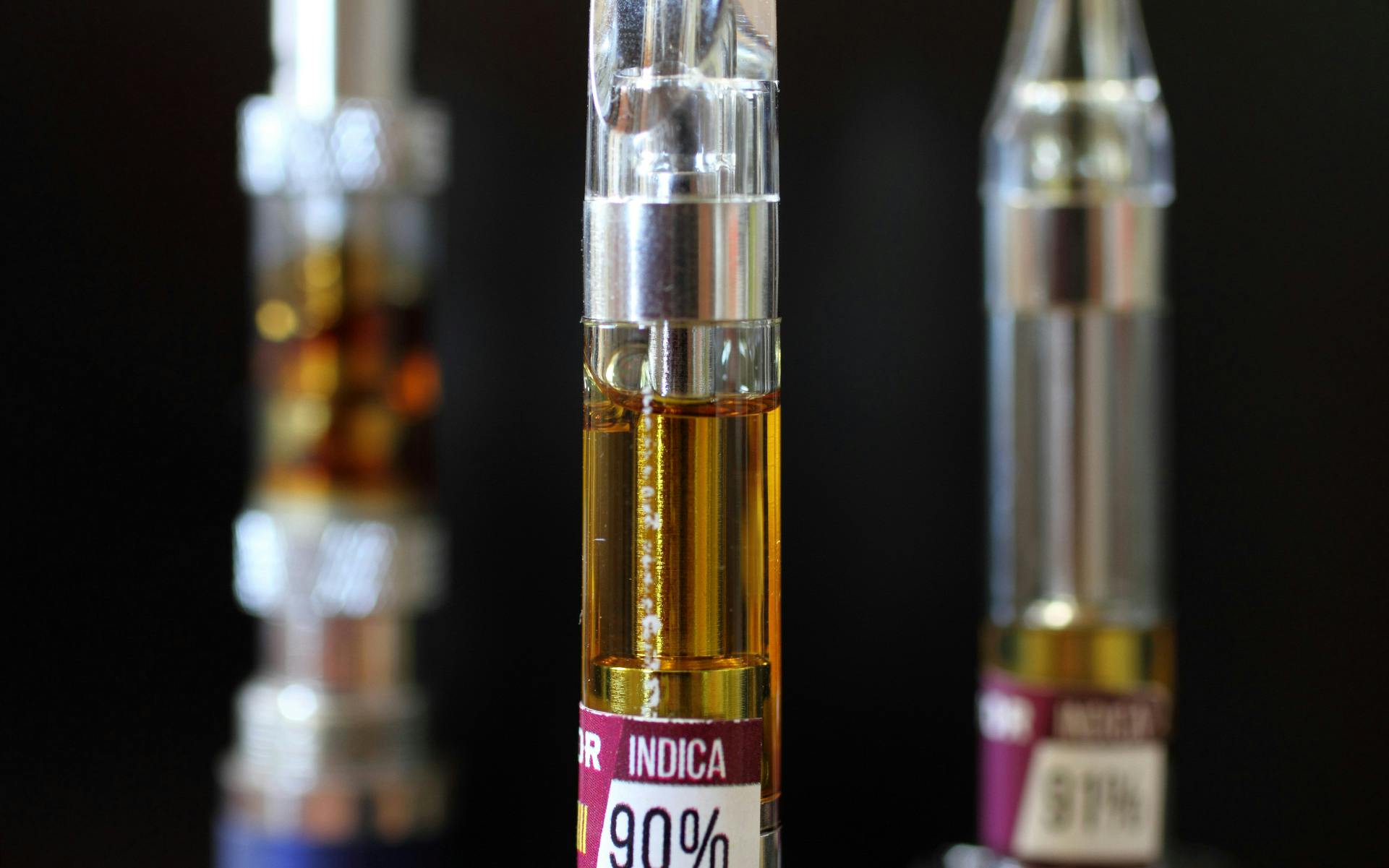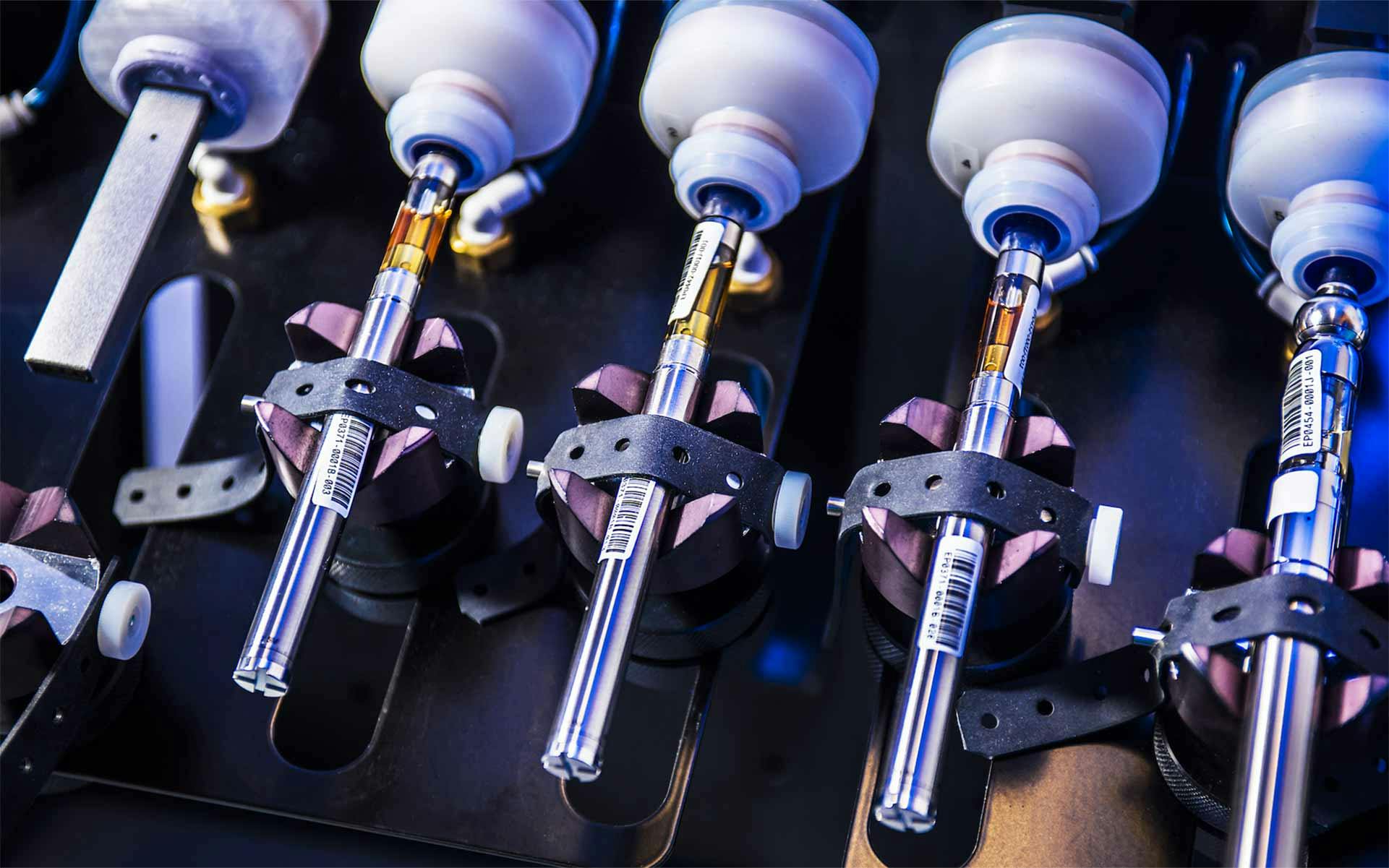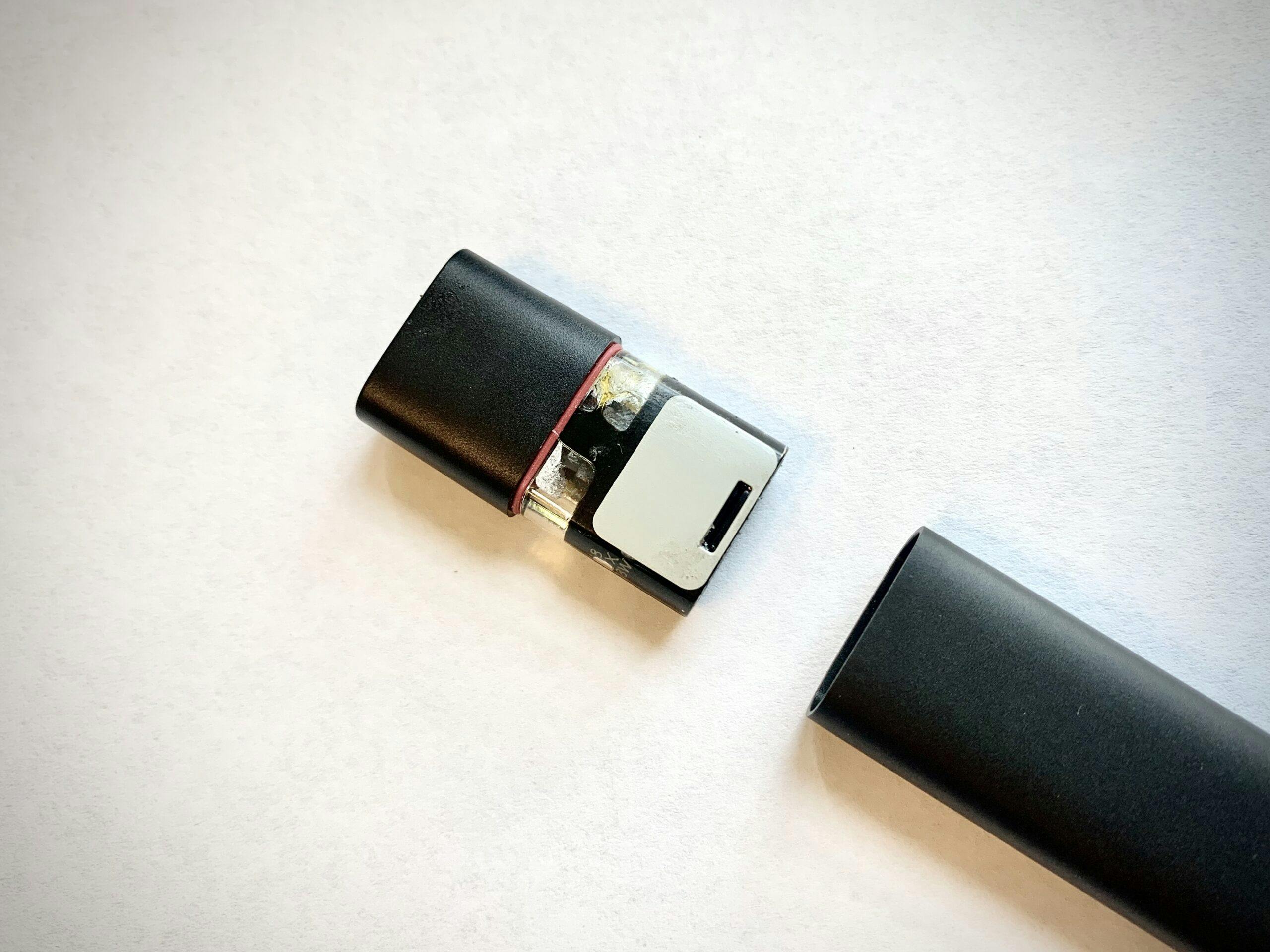In 2019 and 2020, vaping-associated lung injuries killed 68 people and injured 2,807 across the United States. As reported by Leafly and later confirmed by officials at the Centers for Disease Control and Prevention (CDC), those injuries and deaths were almost exclusively associated with unlicensed THC vape cartridges purchased from the illicit market.
At the heart of the health crisis was a relatively new vape cartridge additive known as vitamin E acetate. Unlicensed cartridge manufacturers were using the substance, a common ingredient in beard cream, to thicken the cartridge oil and boost profit margins.
After the poisonings, officials at the CDC said the number one thing state cannabis regulators could do to protect public health was ensure that “chemicals of concern” like vitamin E acetate did not enter the state-licensed THC vape cartridge supply.
As of early 2021, cannabis regulators have not done that.
Leafly’s comprehensive review of THC vape cartridge rules in the 15 legal cannabis states found loopholes where chemicals of concern can get in.
A Leafly investigation into current and forthcoming regulations around THC vape cartridges in the 15 legal cannabis states reveals that more than a year after the vape lung (also known as EVALI or VAPI) crisis, a few states have banned vitamin E oil, but not a single state upgraded its THC vape cartridge testing requirements up to the standard currently required for all nicotine vape cartridges in Europe and Canada.
State cannabis regulators have generally done a great job of protecting the health of consumers by requiring tests for toxins like pesticides, residual solvents, heavy metals, mold, and bacteria. Manufacturers are also required to test and disclose the exact potency of every product on the label.
But sometime around late 2018, THC vape cartridges escaped the bounds of those safeguards. A new wave of novel cartridge oil additives, thickeners, thinners, diluents, and artificial flavors began flooding the market. The new additives were mostly limited to illicit-market vape carts, but a few seeped into the legal regulated market as well.
Those new additives included:
- Vitamin E acetate, aka beard cream oil
- Squalene, a shark liver oil substance
- Thousands of food flavorings not approved for inhalation
What kept these toxins from flooding into the legal THC vape supply? Only the good conscience of many licensed vape cartridge manufacturers—and a bit of luck. Nothing in the regulatory system of any state would have prohibited most of the new wave of additives.
Even today, the existing patchwork of state rules—with their yawning safety gaps and a total absence of federal oversight—has experts throwing up their hands.

Vape chemistry and regulations expert David Heldreth Jr. stepped down as the Chief Science Officer of a vape flavoring company. “It’s painful,” he told Leafly. “It’s one of those things where the industry just popped up and grew so quickly, it’s really difficult to keep up with what people innovate.”
CannaCraft, California’s biggest vape maker, forbids non-cannabis ingredients in its products, citing a lack of safety data. But the only thing keeping the company from adding mystery flavorings is the integrity of company officials. Many in the industry are doing it right. Others have less scruples. Consumers have few ways to tell.
“I think we do a lot of things well, but there’s certainly room for improvement,” said Matthew Elmes, a molecular biologist and Director of Scientific Affairs for CannaCraft. “There are so many things that aren’t tested for, and we don’t know, as consumers, what’s going on there.”
Leafly’s comprehensive review of THC vape cartridge rules in the 15 legal cannabis states found loopholes where those chemicals can get in.
Those gaps exist in three major categories: emissions testing, known toxins, and mystery additives.
Safety gap 1: emissions testing

None of the 15 adult-use states and the 20-plus medical states currently requires manufacturers to test vapor coming out of a vape pen. This is known as “emissions testing,” and it’s required of all nicotine vaping products in Europe and Canada.
Here’s why it matters. Experts said emissions tests can reveal heavy metals found not in the raw cannabis oil but in vapor from shoddy devices, or toxins from burning unsafe mixtures.
Vaping expert Arnaud Dumas de Rauly, chairman of the International Standards Organization (ISO) committee on vapor products, told Leafly, “Every state should be doing emissions testing—100%.”
“I personally would feel the safest seeing those [emissions] results,” said CannaCraft’s Matt Elmes. “A lot of the cheaper hardware or pens that operate at higher temperatures certainly have the potential to leech extra heavy metals into that oil upon use.”
“We’re talking about consumer safety. Without it, our industry will just die.”
Arnaud Dumas de Rauly, chairman of the International Standards Organization (ISO) committee on vapor products
“We’re talking about consumer safety,” added Arnaud Dumas de Rauly. “Without it, our industry will just die.”
Emissions testing technology already exists. Europe and Canada require it. What’s lacking in the United States? The political interest and will to adopt a testing standard.
That’s starting to change—but far too slowly. Colorado will become the first state to mandate emissions testing, next year in 2022.
No other state has a THC vape cartridge emissions testing requirement in the pipeline. Even in Colorado, millions of cartridges will sell between now and 2022.
Safety gap 2: known toxins
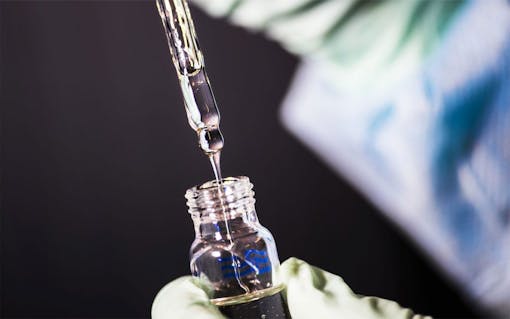
The world’s largest legal cannabis market, California, never explicitly banned vitamin E acetate, which caused the vape injury outbreak in 2019 and 2020. The nation’s biggest industry trade group, the National Cannabis Industry Association (NCIA), recommends a complete ban of the substance. Both regulated manufacturers and illicit ones seem to have stopped using it when VAPI hit.
Washington, Colorado, and Oregon have banned the substance. But other legal states have not followed.
In California, state regulators only require manufacturers to disclose that a vape cartridge contains vitamin E acetate. That’s like allowing Coors to add a little bathtub gin to every beer as long as they disclose its presence on the label.
Safety gap 3: mystery additives and flavors

Most state cannabis regulations never mention the words “additive” or “flavoring,” two of the biggest vectors of harm in vape pens uncovered in last year’s lung injury outbreak.
Nine years after legalizing cannabis, officials in Washington state will finally—this month—begin taking public comment on the definition of a “flavor,” and create a process for banning toxins from vape cartridges.
National Cannabis Industry Association media relations director Morgan Fox endorsed the idea, saying it’s “appropriate and useful” for all states to create a banned additives list—as well as a rigorous and transparent process to decide which substances are added or removed from the list.
Potential solutions
Many experts say state vape safety rules need upgrades to a new baseline founded upon the precautionary principle. That is: Anything non-cannabis gets prohibited unless and until it’s proven safe for human inhalation.
Rules updates should happen before—not after—the next outbreak of lung injuries. This is about fortifying the legal markets amid the collapse of prohibition.
“I think banning entirely, or at least limiting, the types of diluents or additives in inhalable oil absolutely should be discussed in the future regulations,” said CannaCraft’s Elmes.
Other experts worry about the unintended consequences of bans. Dramatic overreach, they say, could drive millions of consumers to the illicit market, which contains more and higher levels of inhaled toxins.
Dr. Jahan Marcu, editor in chief of the American Journal of Endocannabinoid Medicine, helped author the American Herbal Pharmacopoeia’s imprint on cannabis quality assurance. Marcu prefers a mix of bans, moratoriums, mandatory disclosures, and allowed additives, depending on the substance.
“We want to avoid going from a bad situation to a potentially worse situation,” Marcu said. “We need better data from products [currently] on the market.”
What consumers can do
Until state regulators get around to updating THC vape testing rules, there are a few basic steps consumers can take to minimize the risk of inhaling toxic additives.
Those include:
- Purchase only from state-licensed cannabis stores.
- Use only licensed brand products.
- Avoid products with vague ingredients.
- Look into a brand’s stated vape oil practices—it’s often posted on their website.
- Ask your budtender hard questions about what’s in a vape cart, and how they know it. If they can’t answer, they’ll start asking hard questions of their suppliers. Consumer pressure works.

“I’ve talked to a number of producers who refuse to use anything that’s not cannabis-derived,” said Morgan Fox, at the National Cannabis Industry Association, which published a white paper on vape safety rules in 2020. But it’s not easy to find out who those producers are when you’re standing at the merch counter with a line of customers behind you.
Be on the lookout for vague ingredients. Potentially dangerous or contaminated additives are sometimes labeled as “natural flavorings.”
The FDA never approved a “natural” “flavor” for use on lung tissue. Quite the opposite: exploratory research keeps finding new harms from inhaling additives and flavors.
Marcu, who co-founded a pro-cannabis consultancy, Marcu and Aurora, in Washington state, said he doesn’t use legal vape pens right now.

“I don’t want to pooh-pooh anyone’s product,” he told Leafly. “But it seems to me that I do not trust most vape [cartridges] on the market unless the company has a good toxicologist on staff.”
Heldreth Jr., now-CEO of hemp food company Ziese Farms and biotech firm Panacea Plant Sciences, also said he’s not buying vapes in Washington.
“I don’t particularly buy them in general,” he said. “When I did, I was always the person that would use cannabis-only vape products.”
Consumers who want the smooth draw of vapor without any chance of unknown additives should try dry herb vaporizers like the Volcano or the Pax 3. This class of products vaporize cannabis flower, which undergoes required testing in legal markets. It’s super-safe. For example, the Volcano vaporizer has been used in FDA-approved trials.
“I fully agree with working within the plant,” said Dumas de Rauly.
Part 2: What’s in your vape cart? An expert guide to the new additives
What we now call a “vape” grew up from the Chinese-patented e-cigarettes of the 1990s to today’s popular product: a small reservoir of THC oil that screws into a pen-sized battery base. Drawing on the mouthpiece triggers a smoldering, red-hot element that heats the oil mixture, creating vapor, but also burning the oil.
Marijuana legalization did a great job of setting the first quality control baselines for vapes in the US.
Most medical and adult-use states have rules prohibiting the presence of pesticides, residual solvent, heavy metals, and mold. That’s great.
In 2020, Leafly found that states with legal vape markets are about 10 times safer than prohibition states. The per capita injury rate from vaping is far higher in prohibition states like Utah and Wisconsin, as compared to California or Oregon.
But to maintain that safety edge, regulators need to upgrade rules to keep pace with the practices of the time.
The CDC dubbed vaping injuries the biggest “respiratory epidemic” in the US in 2019. In 2020, the coronavirus pandemic totally eclipsed the issue. But as COVID recedes, vape injuries will likely become news again.
That’s because tainted vapes haven’t totally gone away, Oregon regulators told Leafly in December. The profit motive to dilute THC oil hasn’t faded.
California officials reported a few vape injury cases in 2020 where COVID was ruled out. After a year of study, Oregon enacted an emergency ban and recall on tainted vapes in stores in December.
The new chemicals of concern
Marijuana legalization has become a movement. Unfortunately, the movement picked up some freeloaders: chemicals added to the vape supply to make more money.
For example, the text of California legalization Proposition 64 never says the word “additives,” “thickeners,” or “flavors.” So how did legalizing THC result in thousands of other substances potentially being allowed?
“That’s a good question,” said Dr. Marcu. “I think the issue has always been this explosion of product differentiation, and no guardrails were provided, or avenues to study these products were provided.”
With federal research all but banned, Heldreth said vape makers, stores, regulators, and customers generally lack the chemistry and toxicology expertise to self-regulate.
“It’s people misunderstanding chemistry and health,” Heldreth said.
Also, some cannabis lobbyists are trying to ensure non-cannabis chemicals are allowed in inhaled cannabis products.
“It’s the crossroads of the industry growing and having more and more lobbyists and some of those lobbyists not knowing anything, because we don’t have research,” said Dumas de Rauly.
Which chemicals are the biggest cause for concern? Let’s start with the most suspicious chemicals and work our way down.
Diluent thickeners
In 2019, the world learned you could boost profits by diluting pure THC oil. You just had to find a thick, clear, tasteless goop that could fool consumers and boom: 10 times the profits. Two leading examples, vitamin E acetate and squalene, seem pretty toxic.
“A lot of people are doing this just to increase their profit margins by diluting their product,” said Elmes. “There’s loads of compounds that people are using as diluents in cannabis oil and we don’t know the long-term safety of those compounds.”
Some cutting agents should’ve seemed dumb, even to a lay person.
“Squalene—who the hell would add shark liver oil to a vape? I mean that just doesn’t make sense,” said Dumas de Rauly.
“I would absolutely ban MCT oil. It’s been proven toxic for inhalation.”
—Dumas de Rauly, ISO committee chairman on vapor standard
Squalene is allowed on the skin, or for eating, because the skin or stomach uses layers of protection, or enzymes, to filter out or degrade toxins. Lung tissue has no such layers or enzymes.
The ISO chairman personally favors a national moratorium on squalene in vapes, “saying, ‘It’s banned for now until someone can prove it’s safe’—maybe that’ll get cannabis companies off their asses and doing the research.”
Beyond those two major chemicals of concern, some states have banned MCT oil while others have not.
Dumas de Rauly would ban MCT oil. “I would absolutely ban MCT oil. It’s been proven toxic for inhalation,” he said.

Then there’s old-school cutting agents in e-cigarettes since the ‘90s: vegetable glycerin (VG), propylene glycol (PG), and polyethylene glycol (PEG).
Dumas de Rauly would ban PEG and put a moratorium on VG and PG, though PG may prove safe to inhale.
But again, here the expert Marcu, at the boutique cannabis and psychedelic consulting firm Marcu and Aurora, warned against “regrettable substitutions.”
He said regulators should flag the additives as “under review,” because the current body of early research lacks vigor.
“We’ve already been through a cycle of regrettable substitutions and it’s not getting any better right now.”
Dr. Jahan Marcu, vape chemistry and regulations expert
“I would just want to know what the toxicity of it [is] before we got rid of it. We’ve already been through a cycle of regrettable substitutions and it’s not getting any better right now,” Marcu said.
“We went from PEG, to PG, which we had known risks, to MCT oil, to then something we knew even less about, vitamin E acetate. Where does it end?” Marcu added. “I think moratoriums or bans can work while you generate some data.”
Artificial flavors, tastes
Non-cannabis terpenes, aka ‘botanical terpenes’
Cannabis science is abuzz with research on the aroma molecules in pot, the terpenes. There are more than 100 terpenes made by the cannabis plant, and thousands more made in nature.
Sometimes, cannabis companies try to boost flavor by adding in extra terpenes, either from cannabis or not.
Other times, companies try to save money using terpenes from cheaper sources than cannabis. Low-cost non-cannabis terpenes can be low-grade, and contaminated with toxins, Oregon and Washington lab tests show.
“[Third-party terpene makers] are not nearly as regulated as the cannabis industry,” said Morgan Fox at NCIA.
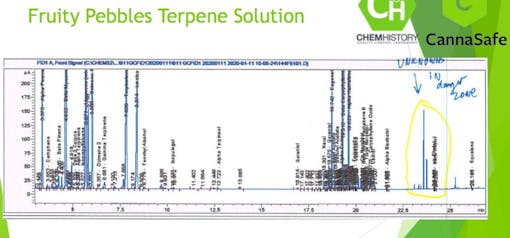
Dumas de Rauly said vape companies are buying terpenes off the shelf without testing the stuff for purity.
“You need to do your due diligence on your suppliers, and no one is doing it. They’re saying, ‘Hey, let me mix it. If it tastes good, I’m going to buy it,’” Dumas de Rauly said.
Terpenes are not all equal
Cannabis terpenes come in two types of small molecules—monoterpenes and sesquiterpenes. They are more heat-stable.
Non-cannabis terpenes can be bigger, said Elmes. Heating up some of these bigger molecules, like the triterpene squalene, can break it, creating new “more dangerous” compounds.
Too much of a good terpene
Furthermore, artificially high concentrations of cannabis terpenes—like limonene—can be toxic on their own, no contamination needed. In nature, terpenes make up less than 5% of weed by weight.
Dumas de Rauly recommends capping terpenes in vape oil at 15%. That limit will vary by the terpene.
“Certain terpenes above a certain concentration degrade into volatile organic compounds that are carcinogens,” said Dumas de Rauly. “Sometimes we should be using no more than X percent terpenes in products. When there’s more, you get some bad products.”
Phytol, as well as ‘chiral’ terpenes
There are two more terpene additive issues emerging.
Even low, unheated concentrations of certain rare cannabis terpenes might prove problematic. The terpene phytol proved toxic to rats in a small new inhalation study. Phytol additive is already de facto banned in Canadian THC vapes, said Heldreth.
Non-cannabis terpenes may be slightly different than cannabis terpenes, but in meaningful ways. There’s a difference between cannabis-made “L-limonene” and “D-limonene,” sourced from lemons, said Heldreth.
Furthermore, terpenes can be “chiral”—that is, left or right-handed versions. Chiral molecules are mirrors of each other, but not equivalent. Sometimes left and right-handed versions do totally different, dangerous things. (Google “thalidomide,” for example.)
Specific versions of terpenes may prove more dangerous for inhalation, said Heldreth. “This is groundbreaking science that’s not even public yet.”
Conversely there may be some situations where non-cannabis terpenes prove safer, Marcu. We don’t know. We need the inhalation science.
“What we need to figure out is: dose, hazard, and risk,” said Marcu.
Food flavors
Lastly, thousands of chemical flavorings only approved for the stomach are making their way onto the lungs.
Think of your grape flavors, your bubblegum flavors—they’re proven safe to eat, not huff. And yet they’re allowed in many state-legal THC vapes. Voters didn’t legalize this.
CannaCraft’s Elmes said it’s time to keep the flavors out.
“Full-spectrum cannabis oil has great flavor on its own. I see no reason to risk a person’s health just to add some artificial flavor compounds,” he said.

Dumas de Rauly said safety data exists on some flavors from years of nicotine vaping. A synthetic strawberry flavor can be made non-carcinogenic, for example.
But none of those non-cannabis chemicals are what voters specifically legalized.
If you want to legalize non-cannabis grape flavor in THC vapes, try and amend the law, or run a new initiative.
Part 3: Here’s how your state tests THC vapes (or doesn’t)
Synthetic strawberry, as well as skin cream ingredients, are seeping into our legal THC vape supply, due to a federal leadership vacuum. Meanwhile, a patchwork of outdated state rules, or lack thereof, are being skirted by a rapidly evolving industry.
At the top, the federal government has neglected its role as the main regulator of all electronic drug-delivery systems. E-cigarettes have existed since the 1990s. A generation later, the FDA in 2021 is asserting authority over the multi-billion nicotine vaping industry.
Federal marijuana prohibition means the feds have no say over THC vape ingredients in the country’s vast, multi-billion-dollar illicit market.
And where the feds have oversight, they don’t exercise it. To date, the FDA lacks any oversight over CBD vape pens that contain less than 0.3% THC, so long as there’s no nicotine or other drugs in there. Add whatever beard creams you want.
“It would be nice to have federal guidance,” said Fox at the NCIA. “Because a lot of [state regulators] don’t necessarily have the knowledgebase for products like this—let alone non-cannabis products.”
Heather Despres, a cannabis quality control expert, scientist, and Director of the Patient Focused Certification (PFC) program at the leading advocacy group, Americans for Safe Access, agreed.
“The states have this patchwork that makes it difficult. If there was some type of minimum federal standard for production, then I think certainly that will go a long way to helping states put their attention to things that are really going to be affecting patients and consumers.”
Instead of legalization, standards, and guidance, the federal bureaucracy wants more research into pot’s harms. They outline an 8-step research approval process that’s among the most onerous in science.
Meanwhile, reviewing each state’s vaping regulations reveals what you’d expect: It’s like a pack of sliced swiss cheese. Every slice has slightly different holes.
Alaska
Alaska mandates testing for the basics like potency, pesticides, solvents, metals, mold, etc. However, the rules don’t mention the biggest suspects in the last two years of lung injuries: additives and flavors. Labs don’t have to test for them.
Arizona
Arizona cannabis regulations call for testing for old-school contamination: potency, heavy metals, microbes, pesticides, etc.
However, Arizona rules never mention vitamin E acetate, squalene, or the word “additive” with regard to vapes, nor do they mention the word f”lavorings,” “terpene,” or “emissions test.”
California
In California, the biggest legal market in the world, regulators never banned vitamin E acetate, the Centers for Disease Control’s main culprit in the 2019 injuries.
Nor did California ban squalane and squalene, which Oregon regulators suspect is associated with their injuries. Nor did California ban MCT oil like Colorado, Washington, and Oregon did.
Instead, California regulators point to an ingredients disclosure requirement.
“CDPH regulations require all ingredients (and sub-ingredients, if applicable) to be disclosed on the label which allows consumers to make informed choices about the products they purchase and use,” the BCC said in a statement to Leafly.
However, state cannabis labs are not required to test for harmful additives, said expert Josh Wurzer, head of SC Labs.
“I can tell you for sure it’s not routinely tested for. If someone were to do it, it would not get detected during compliance testing.”
—Matt Elmes, CannaCraft
According to Elmes and others, any number of potential toxins could slip through California’s world-class regulations: vitamin E acetate, squalane, MCT oil, or PEG.
“I can tell you for sure it’s not routinely tested for,” said Elmes. “If someone were to do it, it would not get detected during compliance testing.”
Nor has California enacted emissions testing, set to begin in Colorado in 2022. Testing vapor instead of raw oil will reveal heavy metals leaching into the vapor path, or dangerous new chemicals created by burning mixtures of additives, flavors, and THC.
“I fully support Colorado’s mentality,” said Elmes at CannaCraft. “A vape aerosol emissions test is going to tell you 1) the vape oil you’re using is clean, and 2) the hardware you’re using is clean.”
CannaCraft said California officials should immediately move to prohibit dangerous additives and flavors in vape pens. CannaCraft uses only pure cannabis oil and cannabis-derived terpenes in its cartridges.
Government inaction also hurts consumer confidence. Even though CannaCraft might advertise its purity, a consumer has no way to confirm it, “unless you pay out of pocket to ask a lab to check your product,” Elmes said.
The BCC should start testing products off shelves in a state lab for ingredients labeling accuracy, he said.
Colorado
Colorado takes the trophy for being the first state to enact emissions testing, but the program is still a year away. The state also has the most bans on these novel chemicals.
Colorado bans vitamin E acetate, as well as MCT oil and PEG. Non-botanical terpenes are also banned.
But it’s not clear what’s going on with botanical terpenes like stuff from olive trees or lemons, or what the state is doing about artificial flavorings. And Colorado’s pesticide rules aren’t great.
On one hand, some pesticides are prohibited and tested for, but there is an allowable pesticides list in Colorado as well.
Illinois
Illinois cannabis regulations cover the basic stuff, but don’t mention this second wave of adulterants. Illinois tests mold, fungus, pesticide, solvent, and potency. The rules don’t mention “additive,” “flavor,” non-cannabis terpenes, or other new vectors of harm.
Due to its massive illicit market, Illinois had some of the highest vape injury rates in the country in 2019. The state’s legal program began on Jan. 1, 2020.
Maine
Maine under-regulated its medical cannabis industry for years, then slow-walked the implantation of adult-use legalization. Stores opened in October 2020 and just two licensed labs serve the state. The state offers the usual panel: potency, mold, fungus, solvents, and metals.
Maine has the legal right to mandate testing for “poisons” and “toxins.” However, second-generation vape contaminants—additives, flavorings, etc.—aren’t mentioned in the rules or in mandatory testing.
Massachusetts
Massachusetts labs offer testing for vitamin E acetate, but it’s not mandated under state law or rules. The same loopholes apply to other additives. There is a mandatory disclosure requirement, but labs don’t have to verify complete disclosure.
Pesticides are allowed in Massachusetts cannabis, subject to a ban list. Labs are required to screen for pesticides not on the list.
Michigan
Michigan transitioned from an unregulated medical cannabis industry to a regulated adult-use cannabis industry in 2019, just as lung injuries climbed. The legislature there banned vitamin E acetate, and some labs offer to test for it.
Michigan also recalled tainted medical cannabis vapes pens that ended up on adult-use store shelves.
The state’s rules never mention other the word “additive” or “flavor,” or suspected toxins like squalene, MCT oil, or PEG.
Montana
Montana stands up its adult-use program this year. Under its medical rules, the state tested for first-generation contaminants including pesticides and solvents. The rules never mention “additives,” “flavors,” or other second-generation vape harm vectors.
Nevada
Nevada cannabis does a great job of improving quality over the illicit market. The state tests for pesticides, metals, and the usual. However, Nevada never banned vitamin E acetate, and its rules don’t mention this new generation of adulterants.
New Jersey
New Jersey tries to implement adult-use legalization in 2021, but its medical marijuana era vape rules need updating as well. The state mandates tests for THC, pesticides, heavy metals, etc. But the rules say nothing about additives or flavors like thickeners, thinners, or terpene purity.
Oregon
Oregon had some of the laxest cannabis oversight in the west, and thus, the most cases of confirmed lung injury attributed to licensed products.
So it’s not shocking Oregon wants to evolve from a vape paradigm of “allowed until proven harmful” to “prohibited until proven safe.”
In December, regulators emergency-banned squalane and squalene and MCT oil. Vitamin E acetate is also prohibited.
This year, Oregon’s regulators want to craft a narrow list of allowed ingredients, versus an ever-growing list of prohibited ingredients. But the timeline is unclear.
Until then, Oregon vapers must test their own vapes for purity, or trust company self-disclosures. Labs aren’t required to test for newly prohibited ingredients.
South Dakota
South Dakota voters approved medical and adult-use legalization in 2020, but the state must set those systems up, or write rules for them. The state will remain an illicit market for vape pens for the near future.
Vermont
Vermont is the perfect example of the perils of decriminalization. Cannabis is legal to possess and grow, but not to buy. All commercial cannabis in the state is illegal and untested.
Washington
Washington cannabis quality assurance had problems going into the vape injuries of 2019 and 2020.
Amid 2020’s lung injuries, lawmakers passed a law specifically clarifying that regulators could ban non-weed things from appearing in weed.
Washington officials have “specific authority to prohibit the use of any additive, solvent, ingredient, or compound in marijuana vapor product production and processing and to prohibit any device used in conjunction with a marijuana vapor product.”
For starters, Washington never got the pesticides out of cannabis. There’s a list of allowed pesticides in Washington, but labs aren’t required to test for banned pesticides; not even in concentrates, which can have higher amounts of nasty pesticides.
Regulators do perform some secret shopping and testing, and have found banned pesticides in store products, but consumers don’t know which ones, said Heldreth Jr. The public documents are redacted. Instead, companies like Seattle dispensary Uncle Ike’s spend out of pocket to check for pesticides for their customers. In 2020, Uncle Ike’s tested more than 50 carts on the market for vitamin E—all carts passed the test.
Washington did ban vitamin E oil in vapes, and required disclosure for squalene, MCT oil, flavorings, etc.
A consumer could take a legal pen to a lab and pay for an additives test to see if the label is accurate, said Heldreth, but it’s not happening. “[A producer] could get in trouble, but the likelihood of that is pretty small,” he said.
This year, Washington officials are set to agree on a definition for what a “terpene” is, what a “flavor” is, and what a process to prohibit unsafe additives might look like.
“I myself refuse to vape anything that isn’t full cannabis or utilize any similar products because of what I know.”
—David Heldreth Jr, former Chief Science Office at a terpene company.
One lobbyist wants to include the non-cannabis ingredient menthol. “This is chemistry that is over people’s heads,” said Heldreth.
How comfortable should legal vapers in Washington feel? Not that great, he admitted.
In public comments, Heldreth wrote, “As a former employee of a company that made flavor for vaping I can attest to the danger of allowing non-cannabis ingredients to enter the market. I myself refuse to vape anything that isn’t full cannabis or utilize any similar products because of what I know.”
How cannabis companies can take the lead in safety
While consumers clamor to ban non-cannabis chemicals in inhaled cannabis, companies can go beyond just saying they are additive-free. They can spend extra money on lab testing for additives and publish the results.
“I’m not talking about a potency test,” said Marcu at the American Journal of Endocannabinoid Medicine. “I’m talking about actual data about your product justifying why you put stuff in there.”
“There’s a reason we have 3rd-party testing for every industry. Show me the data, put it out there, show us how you collected it that draws you to your opinions.”
The NCIA’s Fox also said companies can deploy anti-counterfeiting measures, like QR codes, to further separate the tainted pens in the illicit market from the tested ones in stores.
Most vape injuries come from street products, but users often cannot tell a licensed vape from a poisonous knock-off.
Do emissions tests, hire experts
Companies are proactively doing emissions testing to see what their pens are putting out. More should.
“I think it’s pretty important to do regular emissions testing,” said Morgan Fox at NCIA. “Particularly if there are any changes in their supply chain.”
For example, CannaCraft does emissions tests. “We had a hell of a time finding a lab that could do it,” said Elmes. “It’s expensive.”
CannaCraft can publicize those results, further strengthening a brand’s safety claims and attracting safety-minded shoppers.
“What do you think is going to happen when it becomes federally legal? What do you think the FDA is going to say? They’re going to ask for all of this.”
—Arnaud Dumas de Rauly, The Blinc Group cannabis consultancy
Heather Despres at Americans for Safe Access agrees. “It’s on you to prove your product is safe—so that is lab testing. Businesses who are taking those extra steps can provide test results to people. Instead of saying ‘I’m organic,’ you show it.”
Vape companies have to get smarter, too—employ a toxicologist and epidemiologist when developing drugs, said Marcu. “Basically I want them to hire the two most unpopular people in the room at any given time, to provide data to guide company decisions, just like we see for every other major product humans consume.”
The companies that hire the right experts to do credible testing will prosper as legalization advances. Businesses that don’t will fail, Dumas de Rauly said.
“What do you think is going to happen when it becomes federally legal? What do you think the FDA is going to say? They’re going to ask for all of this. Right now, [vape companies] are making the exact same mistake the nicotine vaping industry made five years ago—thinking you’re going to get out of it because you’re going to pay lobbyists. It’s not true. We’re talking about people’s health.”
Consumers can rally for federal legalization
Safety concerns can be a bipartisan rallying cry for national legalization to unlock research, set standards, and create a national baseline for old-school and new-school contaminants.
Legalization created huge leaps in product safety, compared to prohibition. Legal states must maintain that lead.
“I think it’s easily possible to maintain, if not improve upon it,” said Fox at the NCIA.
America is slowly moving down a spectrum, from the dietary supplement world, where you have to prove it’s harmful, to the pharmaceutical drug world where you have to prove it’s safe.
That’s a good thing, said Dumas de Rauly, making an analogy to vaccine development.
“Look at Pfizer. Even for a vaccine that we badly needed a year ago, how long did it take them to put it out? A year. And that is three times faster than a normal vaccine takes. Why? Because people are putting it in their body.”
“Today in vaping, I can literally go buy hardware on Alibaba, I can buy shit product from my local producer, do the extract myself, and sell it legally if I have a license. You find that normal?”
“We can begin by having a checklist: Did you do your toxicology research? Did you do this, do that? A basic list. It’s common sense.”
Despres at ASA said regulators need to keep better pace with the rapid evolution of the industry.
“I have tested products that people would have never imagined someone putting cannabinoids into. That’s the challenge for regulators in this space. The regulations are not evolving at the same rate that the products are, so we need to figure out how to harmonize that.”
Leafly will keep mapping vape safety rules across all of the country, focusing on new chemicals of concern. You can check out our regulations review here, and we’ll update you on progress by year’s end.
